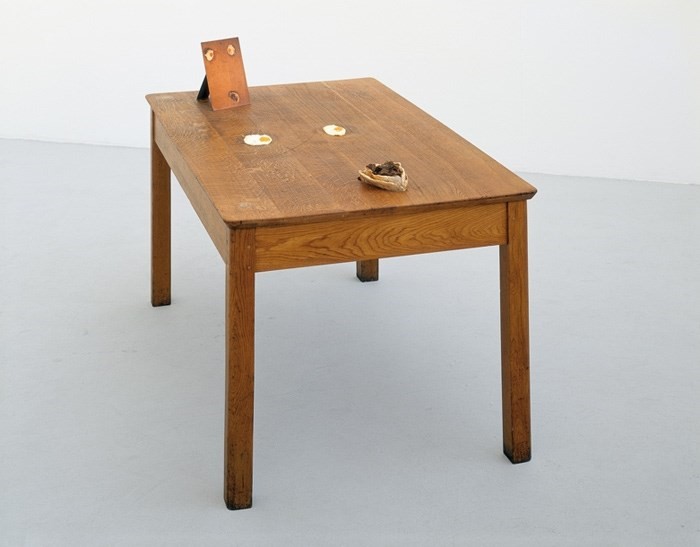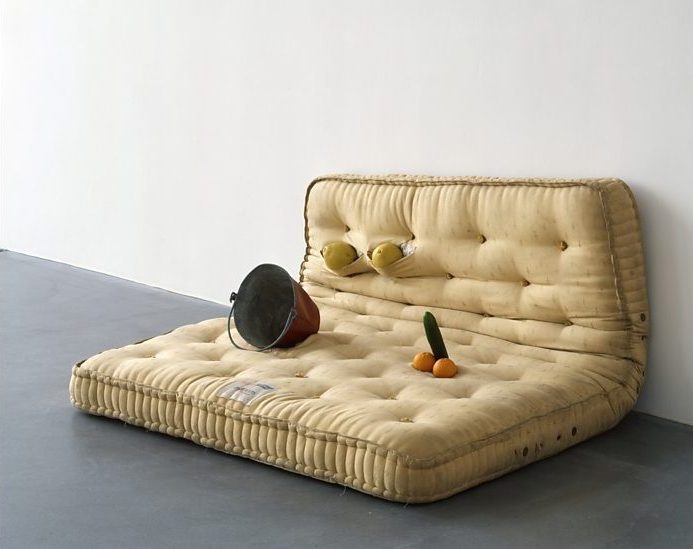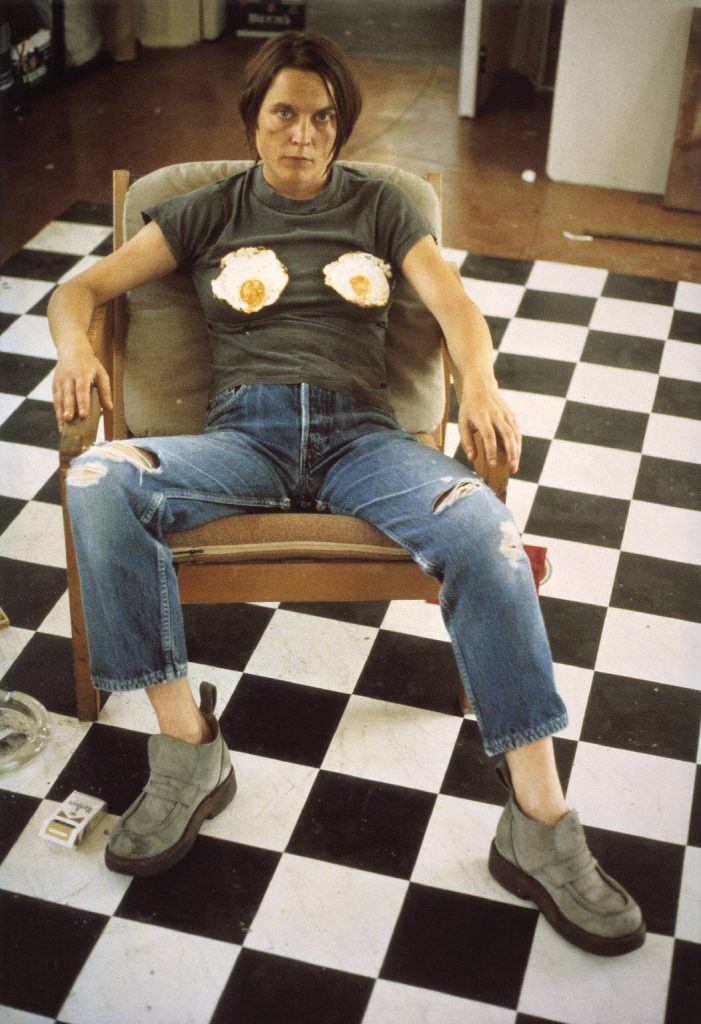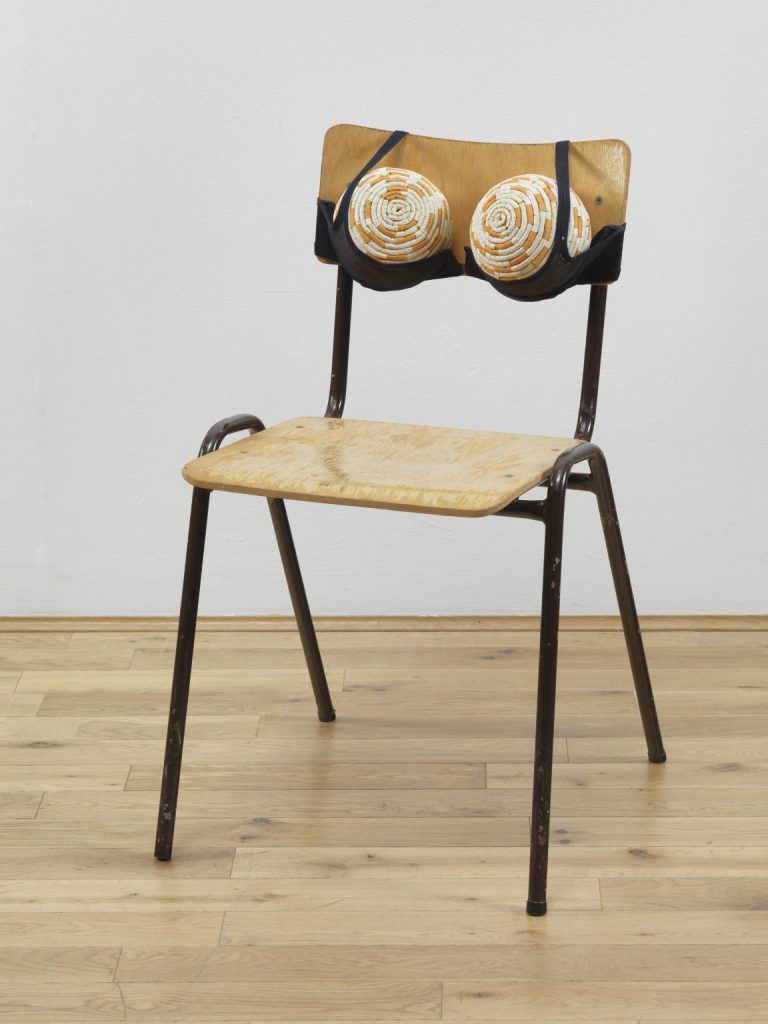5 Ultracontemporary Artists Redefining the Korean Art Landscape
The dynamic South Korean art scene is quickly becoming one of the most prominent globally, blending rich traditions with cutting-edge innovation. And...
Carlotta Mazzoli 13 January 2025
10 January 2024 min Read
With her daring and thought-provoking works, Sarah Lucas challenges social norms and perceptions of gender, sexuality, and identity, earning a reputation as one of the most influential artists of recent decades. Her newest exhibition at Tate Modern in London is on view till 14 January, 2024.
Sarah Lucas (b. 1962) is one of the most famous contemporary artists today, and a prominent representative of British contemporary art. Through her fearless exploration of materials and subjects, Lucas challenges viewers to question their biases and assumptions. She merges humor, subversion, and raw emotion to create a powerful and transformative artistic experience.
The daughter of a milkman father and a part-time gardener and cleaner mother, Lucas grew up in London in the 1960s and 1970s. She dropped out of school at 16, had an abortion at 17, and then hitchhiked through Europe to find her true calling. Upon her return to England, Lucas embarked on her art career, studying first at The Working Men’s College (1982–1983), then at the London College of Printing (1983–1984), and finally at Goldsmiths College (1984–1987), where she received a degree in Fine Art in 1987. In 1988, the artist became part of the initial group of the famous Young British Artists (YBAs), with whom she took part in the Freeze exhibition, organized by Damien Hirst. This show was a seminal experience for British contemporary art of the late 1980s and 1990s and would remain central for a whole generation of artists for years to come.
Together with other British artists, such as Tracey Emin, Lucas influenced not only contemporary art in the UK, but also, on a broader level, the contemporary discourse on gender, feminism, body representation, and sexuality.
In her work, the artist uses everyday objects, drawing upon the legacy of Marcel Duchamp’s readymades, and modifies them to create new sculptural pieces. Lucas’ works are rich and layered, full of details and references. Among the recurring elements, the artist uses furniture pieces as depictions of bodies and body parts and self-portraits, often in photographic renditions, with sometimes explicit and other times more veiled sexual references.
To better understand Lucas’ work and its disruptive power, here are five iconic pieces that summarize her art so far.

Sarah Lucas, Two Fried Eggs and a Kebab, 1992. © Sarah Lucas, Courtesy of Sadie Coles HQ, London, UK.
Among Sarah Lucas’s most famous works, Two Fried Eggs and a Kebab encapsulates her practice and showcases many of the recurring elements in her work. The piece can be interpreted as a sculptural self-portrait of the artist. The central piece is a wooden table upon which the artist placed two fried eggs and a kebab, hence the title, representing her characteristic blend of humor and subversion. The juxtaposition of two fried eggs and a kebab, strategically positioned to mimic female breasts and genitalia, challenges traditional notions of femininity and objectification. Lucas confronts social expectations of women’s bodies, questioning the commodification and reduction of female identity. The piece uses furniture and fried eggs, and recalls the notion of the readymade, making it a staple piece in Lucas’s art.

Sarah Lucas, Au Naturel, 1994. © Sarah Lucas, Courtesy of Sadie Coles HQ, London, UK.
Au Naturel is one of Sarah Lucas’s most celebrated installations. It features found objects such as a mattress, fruits, and a bucket, representing the female and male bodies. In a playful way, this evocative piece confronts the raw, physical aspects of human existence, while also commenting on sexual desire, vulnerability, and the dynamics of power relationships. As the title suggests, this piece is a raw, natural depiction of the couple, with its imperfections and quirkiness. It represents the more direct, perhaps even truer side of their world. There is no preconceived notion of romanticism in this work, no embellished representation of love—just two “bodies” lying next to each other in the most natural and spontaneous way possible.

Sarah Lucas, Self Portrait with Fried Eggs, 1996. © Sarah Lucas, Courtesy Tate Modern, London, UK.
Alongside her sculptural and installation works, throughout the 1990s Lucas created a series of photographic self-portraits. These portraits asserted the artist’s androgynous image and challenged stereotypical representations of gender and sexuality, with the artist posing simultaneously as tough and submissive.
In Self Portrait with Fried Eggs, Lucas employs two of the most recurring elements in her practice: fried eggs and cigarettes. The image captures her confrontational and unapologetic approach to art-making, challenging societal taboos surrounding female desire and sexuality. In this self-portrait, the artist looks directly at the viewer, almost intimidating in her confidence, with fried eggs covering her breasts. By boldly embracing her own body and defying conventional notions of beauty, Lucas empowers viewers to question societal expectations and embrace their individuality.
Together with eggs, furniture, and cigarettes, another recurring element in Lucas’ work are stockings. They are filled with cotton and other padding materials, and arranged to form legs, body parts, and female breasts. These playful yet disconcerting sculptures subvert notions of cuteness and innocence, serving as a critique of gender stereotypes and the objectification of women. The bunnies embody a sense of rebellion and challenge the viewer to confront preconceived ideas about femininity.
The stockings, varying in color from skin-tone to black, recall the idea of a seductress. This is underlined in some of the sculptures through the use of knee-high boots and platforms. The results are eerie sculptures, halfway between inflatable dolls and alien creatures.
The series, which was originally launched in the late ‘90s, is still ongoing.

Sarah Lucas, Cigarette Tits (Idealized Smokers Chest II), 1999. © Sarah Lucas, Courtesy Tate Modern, London, UK.
Cigarettes and smoking are recurring motifs in Sarah Lucas’ body of work. In a 1998 interview with Sarah Kent for Time Out, the artist describes the act of smoking as a moment to herself, a pause that can make time palpable. Through the repeated use of cigarettes, Lucas delves into themes of addiction, rebellion, and self-destructiveness. By presenting cigarettes as symbols of social vice and indulgence, she prompts the viewer to reflect on their own behaviors and the consequences of their actions.
In Cigarette Tits (Idealized Smokers Chest II), Lucas once again confronts social perceptions of gender, desire, and addiction through a compelling visual metaphor. Drawing inspiration from the link between smoking, vices, and bodily aesthetics, Lucas challenges conventional beauty ideals, comparing them to self-destructive vices. By skillfully weaving together themes of identity and consumption, Cigarette Tits prompts a contemplative exploration of the tangled relationship between physicality, aspiration, and social norms.
Sarah Lucas: Happy Gas opened at Tate Modern in London, UK on 28 September 2023. The exhibition presents over 75 works of the artist, spanning four decades. They range from her early sculptures and photographs created during the Young British Artists period, to her latest sculptures using found objects and stuffed tights. The show will be on view until 14 January 2024.
DailyArt Magazine needs your support. Every contribution, however big or small, is very valuable for our future. Thanks to it, we will be able to sustain and grow the Magazine. Thank you for your help!